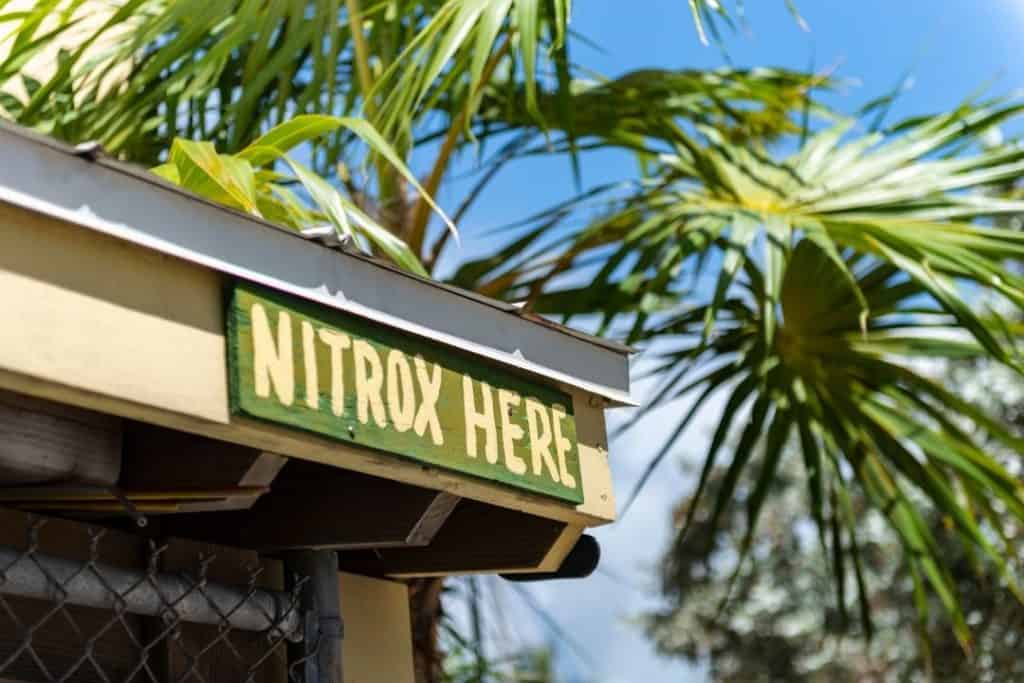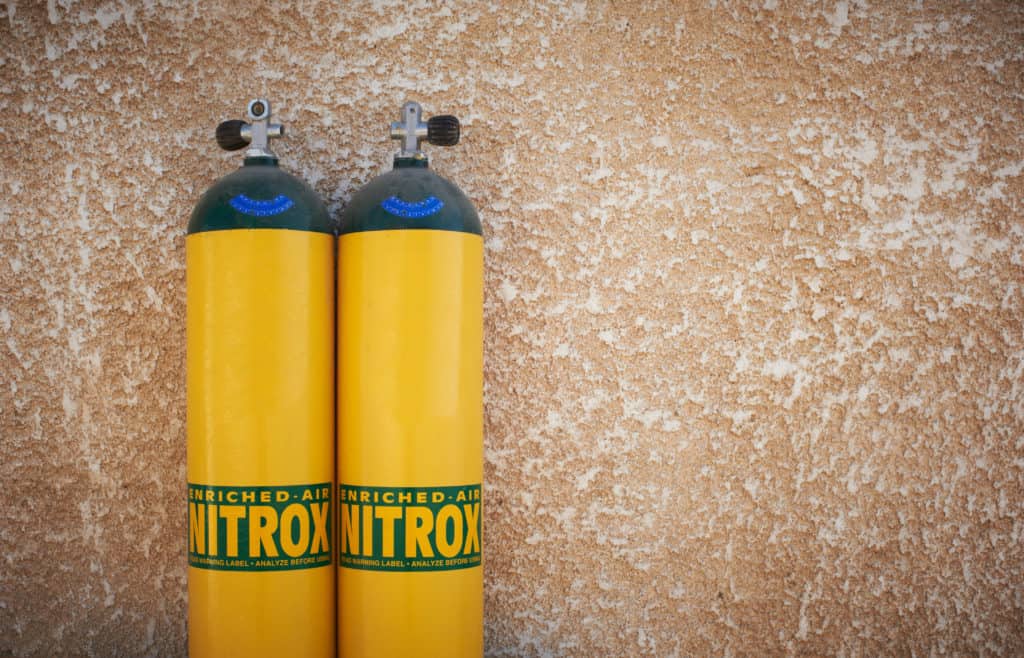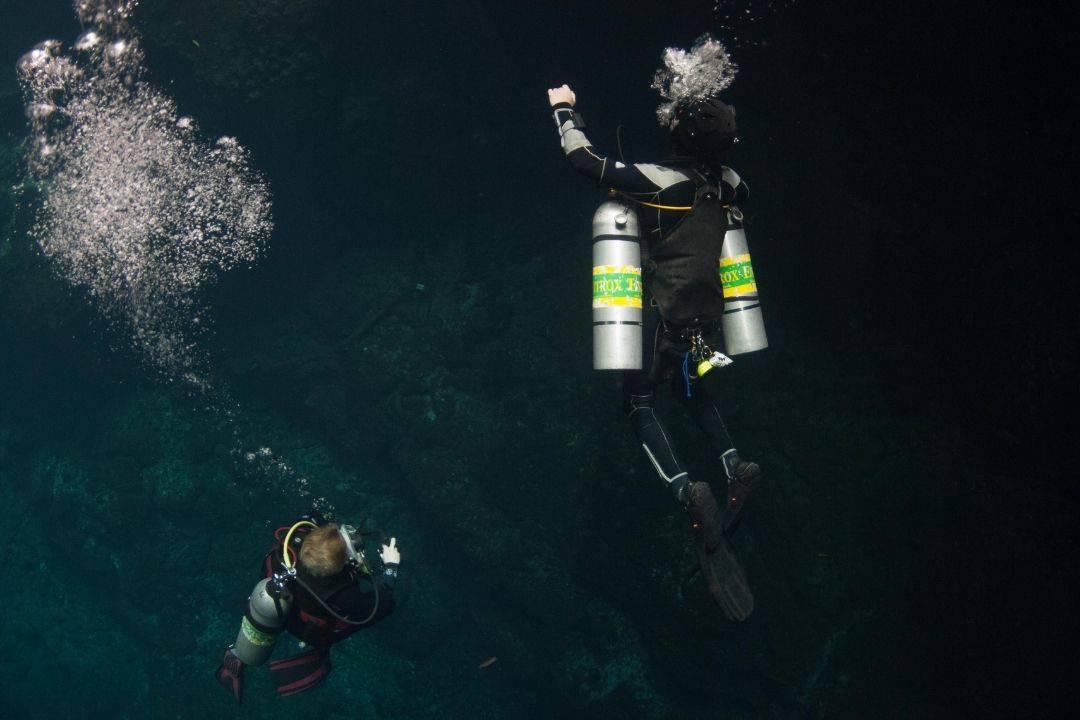There are a wide variety of supplemental certifications a diver can add to their PADI Open Water qualification.
By far the most popular of those is the Enriched Air Diving certification. This teaches divers about the advantages and dangers of diving with enriched air, also called nitrox, and how to dive safely with nitrox.
But Is Nitrox Dangerous?
With proper training, Nitrox is not dangerous. Using nitrox brings the floor for oxygen toxicity inside recreational dive limit, and so long as the diver understands these limits and sticks well within them then nitrox is just as safe as air.
The Main Dangers of Diving With Nitrox

Oxygen Toxicity
The main, and really only, danger of diving with nitrox is exposure to oxygen toxicity.
Using enriched air on a dive brings the floor for oxygen toxicity comfortably up inside recreational diving limits.
In most recreational dive shops, the most common nitrox mix is EANx32 (32% oxygen).
- With EANx32, your maximum operating depth is going to be 111ft.
- Another common nitrox mix is 36% oxygen, with which you can safely dive to 95ft.
In comparison, when diving with regular air the oxygen toxicity level sits at 186ft; far away from recreational divers’ limits.
The level for oxygen toxicity is called a Maximum Operating Depth, MOD, and divers using nitrox need to be sure not to exceed this limit or risk suffering from oxygen toxicity:
Nitrox MOD Table In Salt Water
| Oxygen Percentage | Maximum Operating Depth (ft.) | Contingency Depth (ft.) |
|---|---|---|
| 21% | 186 | 218 |
| 22% | 177 | 207 |
| 23% | 167 | 196 |
| 24% | 159 | 187 |
| 25% | 151 | 178 |
| 26% | 144 | 170 |
| 27% | 138 | 162 |
| 28% | 131 | 155 |
| 29% | 126 | 149 |
| 30% | 121 | 143 |
| 31% | 116 | 137 |
| 32% | 111 | 132 |
| 33% | 107 | 127 |
| 34% | 102 | 122 |
| 35% | 99 | 117 |
| 36% | 95 | 113 |
| 37% | 91 | 109 |
| 38% | 88 | 105 |
| 39% | 85 | 102 |
| 40% | 82 | 99 |
| 41% | 79 | 95 |
| 42% | 76 | 92 |
| 43% | 74 | 89 |
| 44% | 72 | 87 |
| 45% | 69 | 84 |
| 46% | 67 | 81 |
| 47% | 65 | 79 |
| 48% | 63 | 77 |
| 49% | 61 | 74 |
| 50% | 59 | 72 |
The effects of oxygen toxicity include: nausea, dizziness, unconsciousness, convulsions, breathing difficulties, eye damage, lung damage, and, in extreme cases, death.
Suffering from any of these underwater can be bad and unconsciousness and convulsions can be particularly complicating and fatal in an underwater environment.
Oxygen Tanks & Compressor hazards

The diver using nitrox may not require special gear however the job of filling tanks with enriched air has an elevated risk level to it.
The presence of higher than normal levels of oxygen means that the surrounding environment is more susceptible to explosions.
The increased presence of oxygen doesn’t increase the explosivity of its surroundings but it does increase the likelihood of an explosion happening, and when in an oxygen rich environment materials will burn hotter and faster than they would under normal conditions.
Nitrox Composition
Nitrox is an oxygen enriched blend of gases where regular air, coming in at 21% oxygen and 78% nitrogen, has oxygen added to it increasing its oxygen percentage.
Nitrox is also known as Enriched Air Nitrox, EAN or EANx for short. The x is replaced with the percentage of oxygen in the blend where it is known.
The most common nitrox blends used in recreational diving are EAN32 and EAN36, this means that they contain 32% oxygen and 36% oxygen respectively.
Other blends can be found up to EAN40, 40% oxygen 60% nitrogen, and this blend is the recreational limit for enriched air diving.
Identifying Nitrox Tanks

Nitrox cylinders are identified by a large, 4-5 inches wide, yellow and green band that stretches the full circumference of the cylinder close to the crown.
This band says “Enriched Air Nitrox” in yellow letters on a green background, bordered by two yellow stripes.
There will also be a tag hooked over the pillar valve sticking out the top of the cylinder and on this the oxygen percentage, e.g. 32%, will be written.
A diver should always verify the oxygen percentage stated on the tag of their cylinder personally by using an oxygen analyzer.
Safe Use
In order to use nitrox a diver must first obtain the relevant certification from their diving organization; such as PADI’s Enrich Air Diver certification.
More often than not these courses are all classroom and theory based and no dives are required to complete the course.
Once a diver has this certification they will know the advantages and dangers of diving with nitrox and will know how to plan a dive when they’re planning on diving with an enriched air blend.
Modern dive computers have made the dive tables of decades past almost obsolete, and this is true in the nitrox world too.
Most modern dive computers are equipped with a nitrox setting, allowing the user to plug in the mix they’re diving with to obtain a profile for their dive and receive crucial warning signals from their computer should they come close to exceeding their limits during the dive.
Nitrox with up to 40% oxygen, the recreational limit, can be used with standard scuba diving gear, although some manufacturers have their own recommendations so make sure to thoroughly read through the manufacturer’s documentation before proceeding with using standard scuba gear with an enriched air blend.
So why Take The Risk?
Nitrox is most beneficial to divers in the 50-100ft range when they are completing multiple dives in a day. This is why it is often used on liveaboard dive trips.
- Longer Dive Times – Because enriched air nitrox has a lower concentration of nitrogen a diver absorbs smaller amounts of nitrogen into their body tissue with each breath. This means that a diver’s no decompression limit, NDL, is extended quite significantly. For instance: diving with regular air at 18m a diver’s NDL is 56 minutes, when they’re diving with EAN32, nitrox containing 32% oxygen, their NDL is 95 minutes! A huge gain in bottom time. Do remember though that the amount of time a dover can stay down for depends much more on how quickly they use up their air underwater.
- Longer Repetitive Dive Times – Divers can stay down longer on their second, third, and, potentially, forth dives if they’re diving with an enriched air blend. This is due to the reduced nitrogen absorption resulting from their previous dive, or dives, that day.
- Shorter Surface Intervals – Lower levels of nitrogen absorption from breathing the oxygen enriched air from their tank means that a diver can take shorter surface intervals between dives because it takes less time for them to off gas the nitrogen from their tissues.
- Reduced Tiredness – Tests have been done to debunk this myth but many who dive with nitrox swear it to be true: diving with nitrox, they say, takes less of a toll on the body and, therefore, the diver is less tired afterward. One can only find out the truth through personal experience.
It is worth noting that not all of these benefits are available to the nitrox diver simultaneously because dive times and surface intervals are inseparably defined by one another.
The final, un-debunked myth, however, is free for the taking with every day diving!
In Conclusion
With proper use and training, the benefits of nitrox far outweigh the risks when enriched air is properly understood and handled correctly.
What do you think about nitrox now you’ve read the above and enhanced your knowledge on the topic?
Leave us your comments below, along with any question that may have occurred to you whilst you were reading.


